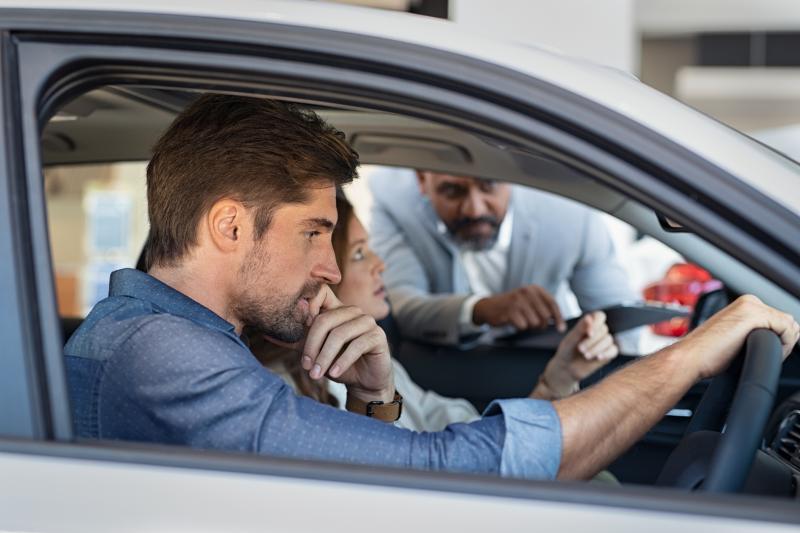
Try not to let your heart rule your head and think hard about whether the car you have in your sight is right for you. One essential step on that journey is the test drive.
Whether you are buying new or used or leasing a car via a popular car finance plan such as PCP (Personal Contract Purchase) or PCH (Personal Contract Hire), a successful test drive should put your mind at rest.
Broadly speaking, buying a used car requires a more extensive test drive than a new car because there's a lot more to check, but there are some universal essentials too.
Before you test drive any car, make sure you’ve done your research. Read reviews of your chosen car online or in magazines and check the model for reliability and safety. If you’re not sure what else you should be researching, we’ve put together a few tips, tricks and questions to ask before test driving a car.
Questions to ask yourself before the test drive
When you arrive for your test drive, it can be tempting to hop in the car and just set off. But before you do, think about the following:
- Can you get in and out of the car easily? If you regularly carry passengers, or a dog for instance, can they?
- Is there space for shopping or luggage? Is it easy to load/unload?
- Is the driving position comfortable? Can you adjust the seat and steering?
- Is visibility good? If you have small children, can they see out of the back?
Now it's time to move onto the test drive.
Test driving a new car
- You might want to try different versions of the model you've chosen (e.g. trim levels, manual/automatic and engine types/sizes). The car you've chosen may also be available as a hybrid (a halfway house between a conventionally powered car and an electric car) or a fully electric vehicle
- If you're buying from a dealer, it may be possible to have an extended test drive over a weekend, or even for a week. If so, go for it, as living with a car is the best way to find out whether it's right for you. If you can only get behind the wheel for an hour or so, make the most of your time.
- If possible, plan a route that includes a mixture of urban, A-roads and motorways so you can get a good feel for the car. Also try hills, and if you regularly carry passengers, take them along too so that you can get a proper idea of the car's performance.
- Don't just drive on smooth roads – try rougher ones to see if the car soaks up the bumps
- Try reversing into a parking space and check for blind spots
- If there's unfamiliar tech on board, such as a built-in sat nav, digital (DAB) radio or drive mode settings (e.g. Eco, Normal, Sport), ask the salesperson to give you a demonstration
- If you're buying a manual car, is the gear-change slick or notchy and is the clutch pedal action right for you?
- If you're buying an automatic, check the gear changes are smooth and well judged, and if there's an instant kickdown when overtaking. Also, make sure there's enough space to rest your left foot comfortably.
- Listen out for annoying noises in the cabin and make sure you're happy with the car's refinement at all speeds – can you easily have a conversation with a passenger at 70mph, for instance?
- Most of all, you should come away from the test drive assured that you can live with the car, it ticks all the right boxes and hopefully it's fun to drive too!
Test driving a used car
- If you're buying second-hand (privately or via a dealer), it's essential to have the car checked out before committing. Take a knowledgeable friend/relative or an independent expert along when you view the car.
- Before the test drive, check your insurance status. Dealers will have special cover in place, but it's possible you won't be covered if you test drive a car sold privately. Ask your insurance company if you’re in any doubt.
- Carry out a thorough exterior and interior visual inspection of the car, looking out for rust and signs of damage, plus panels that don't fit and paint that doesn’t match (a clue to a possible accident repair)
- Before starting the car, check underneath the engine oil cap (beware of a thick white substance which could indicate a problem), then check the engine oil dipstick. After wiping it clean with a cloth, re-insert it, pull it out again and check it’s at the maximum level and the oil itself is golden and clear. If not, the car is probably due a service – a possible bargaining point.
- Now it's time to start it up. Ideally, the engine should be cold before you start the car (feel the bonnet). If it's warm, the seller could be trying to hide a starting problem. Look out for excessive exhaust smoke on start-up, but also during the test drive (especially under acceleration).
- During the test drive, listen for any unusual noises and, if you hear any, try to work out where they’re coming from (e.g. suspension, transmission, steering)
- Don't be afraid to brake hard when it's safe to do so – if the car doesn't stop efficiently in a straight line there may be issues
- The steering should be responsive with no vibrations. Also, make sure you try turning tightly on full lock in a car park
- Use all the gears (including reverse). With a manual car, the gear changes shouldn’t be notchy and if the biting point of the clutch is near the top of the pedal travel, it may be on its way out. With an automatic, the gear changes should be smooth and there should be a decent kickdown when accelerating hard.
- If the car's handling is bouncy or seems unstable (soft or floaty, almost like being in a boat), the shock absorbers may be on their way out
- Test ALL the electricals in the cars, from the electric windows to the lights.
I'm an experienced journalist, digital editor and copywriter, now specialising in motoring. I’m editor of Automotive Blog and have worked across the media in newspapers, magazines, TV, teletext, radio and online for household names including the BBC, GMTV, ITV and MSN. I’ve produced digital content in the financial sector for Lloyds Bank, Nationwide and the Money Advice Service. I'm married with two children and live near Bath in Somerset.



